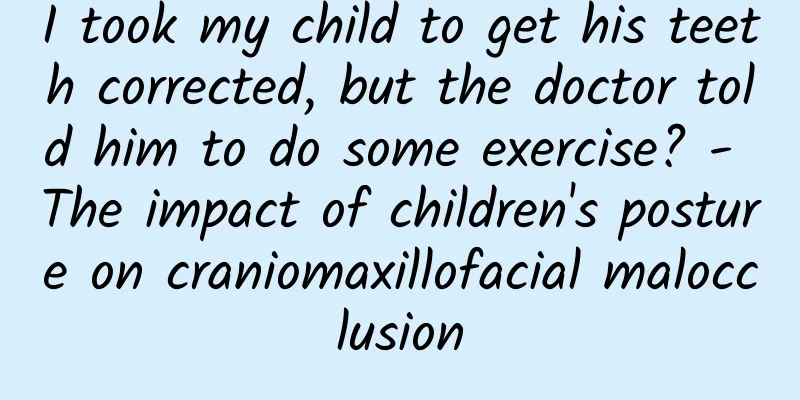I took my child to get his teeth corrected, but the doctor told him to do some exercise? - The impact of children's posture on craniomaxillofacial malocclusion

|
Author: Peng Yiran, West China Hospital of Stomatology, Sichuan University Reviewer: Li Xiaobing, Professor, West China Hospital of Stomatology, Sichuan University Beibei's mother felt like she had walked into the wrong clinic. She had brought her child to see a dentist for dental problems, but Beibei was diagnosed with "unilateral posterior crossbite" during the school physical examination and was advised to see a dentist, so she made an appointment for pediatric oral correction. She thought it was not a big deal, and heard that it would only require wearing braces, but after the doctor checked the teeth, he looked at the child's face in various ways, asked the child to take off his shoes and stand on the ground, stood up, leaned over, and pressed the muscles on the child's neck and back for a long time. He told her seriously: "It may be more serious during puberty, and surgery may be needed in the future. We need..." Beibei's mother was stunned and didn't listen to the second half of the doctor's words. "Of course I will never have the surgery. Is there any other way?" The word "surgery" kept ringing in Beibei's mother's mind. The doctor replied: "Don't worry, there are still functional factors for the child's jaw deviation. Correction can still alleviate the severity and reduce the probability of future surgery. It is best to do some massage and exercise while cooperating with the treatment." “Massage and exercise?” "Yes, neck muscle massage, sitting and standing training, etc." "I went to the pediatric dentistry department, right?" Beibei's mother finally couldn't help asking, "You are... treating the symptoms without addressing the cause?" The pediatric dentist smiled and said, "Of course, but the mouth is also a part of the human body. Other parts of the body will also affect the teeth, bite and even maxillofacial development, so to treat the bite, you also need to move the whole body!" The importance of balanced posture Our body is like a scaffolding, with a series of bones, muscles, ligaments and fascia interconnected to form a framework of support and balance. When a joint moves, the related muscles will contract in coordination to complete the movement. When one of the muscles loses balance, it may cause the displacement of joints and bones, resulting in abnormal posture and movement patterns, which in turn affects the balance of muscles. The body must be aligned and balanced in three planes of space (sagittal, coronal, and horizontal). When the center of gravity is moved too much in one direction or another, the myofascial chain is forced to generate tension to counteract the increase in gravity on one side, thereby breaking the balance and partially deviating from the neutral position, leading to a chain reaction of whole-body posture. There is a close relationship between posture changes and occlusal dysfunction. Figure 1 Abnormal human posture affects craniofacial structure and occlusal development Copyright images are not authorized for reproduction Abnormal posture in children can cause temporomandibular joint disease The human body is an organic whole, and abnormal posture is closely related to temporomandibular joint disease (TMD). One of the symptoms of temporomandibular joint disorder syndrome is pain in the temporomandibular joint and tenderness of related head and facial muscles, and there may be pain in the neck and back muscles. Targeted head, neck, shoulder and back posture training for TMD patients with abnormal head and neck posture can adjust the balance of head, neck, shoulder and back muscles, improve muscle tension, enhance head and neck proprioception, and thus improve muscle pain in TMD patients. Combined with the treatment of temporomandibular joint disease, it can promote disease recovery and symptom improvement. Abnormal head and neck muscle function in children may lead to malocclusion The balance and coordination of the muscles of the head, neck and stomatognathic system are very important for the physiological functions of the head, neck and oral cavity, and are involved in the processes of jaw development, dental arch formation and occlusion establishment (Figure 1). 1. When the neck muscles are abnormal, such as when there is a difference in tension between the left and right sides of the neck, the mandible, condylar position, occlusal plane, and balance of masticatory muscle function will all be abnormal. When the unilateral tension of the sternocleidomastoid muscle (SCM) and trapezius muscle is high, it will cause the head to tilt to the same side; the lateral tilt of the head will trigger early occlusal contact of the teeth on the same side (tight bite on the deviated side and light bite on the opposite side), causing changes in tooth occlusion and occlusal plane. Therefore, if children with uneven shoulders are not intervened in time, facial asymmetry and bone width imbalance may occur. The deviation of the head and neck, and excessive contraction of the perioral muscles (such as scar tissue formed after injury) will affect the normal growth of the craniofacial region, resulting in occlusal deviation or mandibular deviation (Figure 2). On the contrary, if the perioral muscles are insufficient, it will lead to weakness of the mandibular levator muscles, downward displacement of the mandible, and symptoms such as vertical overgrowth, excessive eruption of posterior teeth, and anterior open bite deformity (Figure 2). Figure 2 Mandibular muscle weakness, vertical overgrowth of the mandible, long face deformity, and open bite of the anterior teeth Copyright images are not authorized for reproduction 2. Children with enlarged tonsils and adenoids who breathe by mouth often have upper airway obstruction and tend to tilt their heads forward and change their head posture in order to have more upper airway space, which leads to changes in the tongue muscles and tongue position, mandibular protrusion, and anterior crossbite deformity (Figure 3). Figure 3 Children with enlarged tonsils, open mouth breathing, and forward head tilt can lead to neck muscle pain and crossbite deformity of bony mandibular development. Copyright images are not authorized for reproduction Treatment of muscle dysfunction in early correction of malocclusion Malocclusion in children is caused by multiple factors, some of which are caused by mouth breathing, abnormal muscle function of the tongue and perioral muscles, masticatory muscles, neck muscles, etc. Clinicians who perform early correction should have a clear understanding of craniomaxillofacial growth and development, head and facial musculoskeletal structure, and muscle function and movement. They should pay attention to collecting comprehensive initial diagnosis information of patients and trace their etiology mechanisms. While correcting malocclusion, posture training of muscles such as the neck, shoulders, and back should be performed, and consultation or referral with a rehabilitation doctor should be conducted when necessary. When children with malocclusion have muscle dysfunction, early posture training can help improve malocclusion. Advice for children and their guardians 1. Babies spend most of their time sleeping and moving around in bed, so they should change their sleeping and head positions frequently to avoid being in the same position for a long time, which can cause asymmetry in the head shape, deformation of the head due to pressure, and affect the normal growth of the face and jaw. Babies should be fed in the correct posture, keeping their body and head positions in the correct position to avoid compression of the mandible during sucking, which can cause mandibular retraction, or excessive protrusion of the mandible during sucking, which can cause anterior crossbite. 2. Guide children to stand and sit correctly: when standing, keep the head and chest up, ribs inward, shoulders naturally stretched backward, abdominal core muscles strong, waist not overstressed, spine in normal physiological curvature; when sitting, the spine is straight and the lumbar spine is in a stable state. Keep it straight when sleeping, and the mattress should not be too soft for growing children. |
>>: [Popular Science Lecture] Analysis of the operating room process: from preparation to completion
Recommend
Causes of dull pain on the left side of a woman's lower abdomen
The lower abdomen is very important for female fr...
More tricks, fun rope skipping has many benefits
Rope skipping has received more and more attentio...
Breast ultrasound examination
Breast color ultrasound is a method used exclusiv...
What are the symptoms of blood inactivity?
For women, since bleeding occurs in every cycle, ...
Popular Science | Are you still lying on your stomach for a nap? Beware of myopia!
As the weather gets colder, it is easiest to feel...
Symptoms of liver and gallbladder dampness and heat in women
When women are diagnosed with liver and gallbladd...
Can I still express milk after I've been weaned for several years?
In fact, many people are very concerned about som...
How long after giving birth can pregnant women use a belly belt?
During the pregnancy stage, women's uterus gr...
How to treat gynecological metrorrhagia
There are many types of gynecological diseases, a...
Brown discharge at 8 weeks pregnant
When women are eight weeks pregnant, they will fe...
Is it okay to have sex when you are pregnant?
You cannot have sex when you are just pregnant, b...
Vaginal contractions during sleep
Vaginal contraction during sleep is a symptom of ...
B How much human chorionic gonadotropin is needed for pregnancy
Generally, if women want to know whether they are...
Mild leucorrhea picture of tofu dregs
The secretions of adult women have no color or sm...
Time to take medicine for medical abortion
Artificial abortion is something that happens fre...









